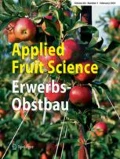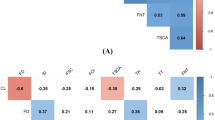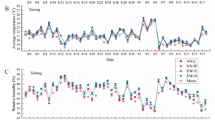Abstract
Three different trunk heights (75 cm, 100 cm, and 125 cm), two grapevine training systems (vertical shoot positioning–shaped and Y‑shaped) were compared for their effects on yield, cluster characteristics, and must composition in Vitis vinifera L. cv. Karaerik in Erzincan, Turkey. We hypothesized that, compared to vines trained with wall-shaped support systems, vines trained with Y‑shaped support systems would have better yield, cluster characteristics, and must composition. Average yield regulations imposed by Y‑shaped support system–trained vines are usually higher than for vertical shoot positioning–shaped support system–trained vines, but similar results were obtained for total cluster number, cluster and berry weight, pruning weight, titratable acidity, maturation index, and total soluble solids among the trunk heights over the 3‑year period. Our results suggest that the trunk heights were insufficient to induce a grow-limiting response of vines, as trunk-height vines did not have lower fruit set, cluster characteristics, must composition, or bud fruitfulness. Although acceptable grape quality was obtained from three different trunk heights and two grapevine training systems, Y‑shaped support system–trained vines had greater total soluble solids at the expense of higher grape yield. We may, therefore, recommend Y‑shaped training systems because the anticipated crop yield increases of this system were logistically superior to an earlier training system. They are also recommended if the anticipated canopy structures of a training system are desired as a crop-regulation tool alternative to the Baran training system.

Similar content being viewed by others

References
Auvray A, Baeza P, Ruiz C, González-Padierna CM (1999) Influence de différentes géométries de couvert vegetal sur la composition du moût. Progr Agric Vitic 166:253–257
Baeza P, Ruiz C, Cuevas E, Sotés V, Lissarrague JR (2005) Ecophysiological and agronomic response of Tempranillo grapevines to four training systems. Am J Enol Vitic 56:129–138
Byrne ME, Howell GS (1978) Initial response to Baco noir grapevines to pruning severity, sucker removal and weed control. Am J Enol Vitic 29:192–198
Cawthon DL, Morris JR (1977) Yield and quality of Concord grapes as affected by pruning severity, nodes per bearing unit, training system, shoot positioning and sampling date in Arkansas. J Am Soc Hortic Sci 102:760–767
Coombe BG (1995) Adoption of a system for identifying grapevine growth stages. Aust J Grape Wine Res 1:104–110
Dokoozlian NK, Kliewer WM (1995a) The light environment with grapevine canopies. I. Description and seasonal changes during fruit development. Am J Enol Vitic 46:209–218
Dokoozlian NK, Kliewer WM (1995b) The light environment with grapevine canopies. II. Influence of leaf area density on fruit zone light environment and some canopy assessment parameters. Am J Enol Vitic 46:219–226
Falcao LD, Chaves ES, Burin VM, Falcão AP, Gris EF, Bonin V, Bordignon-Luiz MT (2008) Maturity of Cabernet Sauvignon berries from grapevines grown with two different training systems in a new grape growing region in Brazil. Cien Invest Agrar 35(3):321–332
Freeman BM, Tassie E, Rebbechi MD (1992) Training and trellising. Viticulture 2:42–65
Gladstone EA, Dokoozlian NK (2003) Influence of leaf area density and trellis/training system on the microclimate within grapevine canopies. Vitis 42:123–131
Howell GS (2001) Sustainable grape productivity and the growth-yield relationship: a review. Am J Enol Vitic 52:165–174
Kalkan NN, Keskın N (2018) The effects of trunk height and training systems on the some physicochemical properties of ‘Karaerik’ berries. Yuzuncu Yil Univ J Agric Sci 28(Spec):257–267
Kalkan NN, Kaya Ö, Karadoğan B, Köse C (2017) Farklı Gövde Yüksekliğine Sahip Karaerik (V. vinifera L.) Üzüm Çeşidinin Kış Gözlerinde Soğuk Zararı Ve Lipid Peroksidasyon Düzeyinin Belirlenmesi. Alinteri J Agric Sci 32(1):11–17
Karadoğan B, Keskin N (2017) Karaerik (Vitis vinifera L. cv. “Karaerik”) Klonlarının Kalite ve Fitokimyasal Özellikleri. Türk Tarım Doga Bilim Derg 4(2):205–212
Karadoğan B, Keskin N, Kunter B, Oğuz D, Kalkan NN (2018) Karaerik (Cimin) Klonlarinin Toplam Fenolik ve Antioksidan Içerikleri Bakimindan Karşilaştirilmasi. Bahce 47(Özel Sayı 1):117–120
Kaya O (2019) Effect of manual leaf removal and its timing on yield, the presence of lateral shoots and cluster characteristics with the grape variety ‘Karaerik’. Mitt Klosterneubg Rebe Wein Obstbau Früchteverwertung 69(2):83–92
Kaya O (2020a) Defoliation alleviates cold-induced oxidative damage in dormant buds of grapevine by up-regulating soluble carbohydrates and decreasing ROS. Acta Physiol Plantarum 42:1–10
Kaya O (2020b) Bud death and its relationship with lateral shoot, water content and soluble carbohydrates in four grapevine cultivars following winter cold. Erwerbs-Obstbau 62(1):43–50
Kaya Ö, Köse C (2017) Determination of resistance to low temperatures of winter buds on lateral shoot present in Karaerik (Vitis vinifera L.) grape cultivar. Acta Physiol Plant 39(9):209
Morris JR, Sims CA, Cawthon DL (1985) Yield and quality of “Niagara” grapes as affected by pruning severity, nodes per bearing unit, training system and shoot positionig. J Am Soc Hortic Sci 110:186–191
Murisier F (1996) Optimalisation du rapport feuille-fruit de la vigne pour favoriser la qualité du raisin et l’accumulation des glucides de réserve. Relation entre le rendement et la chlorose. Ph.D. thesis. L’école Polytechnique Fédérale de Zurich, Zurich
Peterlunger E, Celotti E, Dalt GDA, Stefanelli S, Gollino G, Zironi R (2002) Effect of training system on Pinot noir grape and wine composition. Am J Enol Vitic 53:14–18
Poni S, Marchol L, Intrieri C, Zerbig G (1993) Gas-exchange response of grapevine leaves under fluctuating light. Vitis 32:137–143
Rende M, Kose C, Kaya O (2018) An assessment of the relation between cold-hardiness and biochemical contents of winter buds of grapevine cv. ‘Karaerik’ in acclimation-hardening-deacclimation phases. Mitt Klosterneubg Rebe Wein Obstbau Früchteverwertung 68(2):67–81
Reynolds AG, Heuvel JEV (2009) Influence of grapevine training systems on vine growth and fruit composition: a review. Am J Enol Vitic 60(3):251–268
Reynolds AG, Wardle D, Naylor A (1995) Impact of training system and vine spacing on vine performance and berry composition of Chancellor. Am J Enolvitic 46:88–97
Shaulis NJ (1982) Responses of grapevines and grapes to spacing of and within canopies. In: Davis, Webb CAAD (eds) Grape and wine centennial symposium proceedings 18–21 June 1980 University of California, Davis, pp 353–360
Shaulis NJ, Amberg H, Crowe D (1966) Response of concord grapes to light exposure, and Geneva double curtain training. Proc Am Soc Hortic Sci 89:268–280
Smart RE, Robinson M (1991) Sunlight into wine. A handbook for winegrape canopy management. Winetitles, Adelaide, p 88
Smart RE, Robinson JB, Due GR, Brien CJ (1985a) Canopy microclimate modification for the cultivar Shiraz. I. Definition of canopy microclimate. Vitis 24:17–31
Smart RE, Robinson JB, Due GR, Brien CJ (1985b) Canopy microclimate modification for the cultivar Shiraz. II. Effects on must and wine composition. Vitis 24:119–128
Smart RE, Dick JK, Gravett IM, Fisher BM (1990) Canopy management to improve grape yield and wine quality principles and practices. S Afr J Enol Vitic 11:3–17
Wolf TK, Dry PR, Iland PG, Botting D, Dick J, Kennedy U, Ristic R (2003) Response of Shiraz grapevines to five different training systems in the Barossa Valley, Australia. Aust J Grape Wine Res 9:82–95
Wolpert JA, Howell GS, Mansfield TK (1983) Sampling Vidal blanc grapes. I. Effect of training system, pruning severity, shoot exposure, shoot origin and cluster thinning on cluster weight and fruit quality. Am J Enolvitic 34:72–76
Acknowledgements
This research work was supported by the General Directorate of Agricultural Research and Policies (Scientific Research Project-SRP, project number TAGEM/BBAD/13/AO8/PO4/02) appropriated to the Erzincan Horticultural Research Institute, Turkey.
Author information
Authors and Affiliations
Contributions
N. N. Kalkan designed the study. O. Kaya wrote the manuscript and interpreted the results. B. Karadoğan, Z. Kadioğlu, S. Albayrak, and İ. Esmek were responsible for performance of the research, collection, data analysis, and interpretation.
Corresponding author
Ethics declarations
Conflict of interest
N.N. Kalkan, B. Karadoğan, Z. Kadioğlu, İ. Esmek, S. Albayrak, and O. Kaya declare that they have no competing interests.
Rights and permissions
About this article
Cite this article
Kalkan, N.N., Karadoğan, B., Kadioğlu, Z. et al. Response of Karaerik Grape Cultivar (Vitis vinifera L.) to Two Training Systems and Three Trunk Heights. Erwerbs-Obstbau 64 (Suppl 1), 119–127 (2022). https://doi.org/10.1007/s10341-022-00672-z
Received:
Accepted:
Published:
Issue Date:
DOI: https://doi.org/10.1007/s10341-022-00672-z



